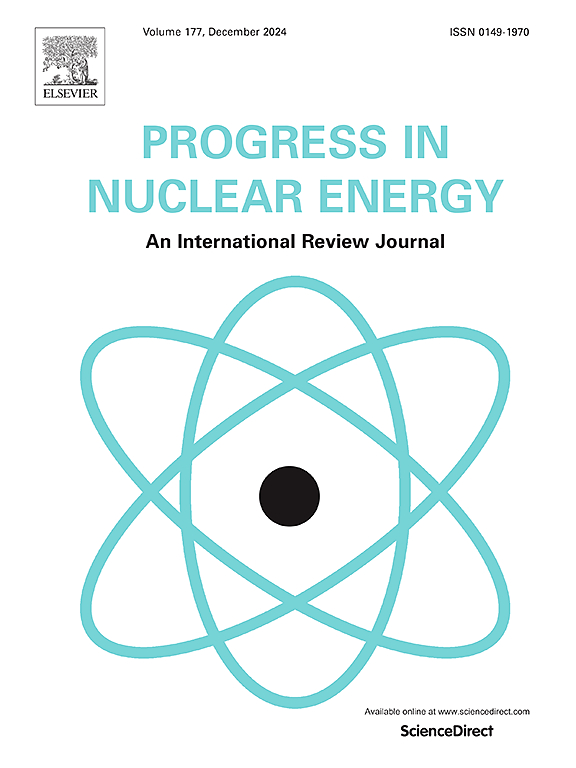Analyzing neutronic characteristics of fuel assemblies and their performance with increasing burnup for Canadian PT-SCWR
IF 3.3
3区 工程技术
Q1 NUCLEAR SCIENCE & TECHNOLOGY
引用次数: 0
Abstract
The Pressure-Tube Supercritical-Water-Cooled Reactor (PT-SCWR) is being explored by the Generation IV International Forum due to its potential to achieve greater thermal efficiency compared to existing nuclear reactor designs. With the DRAGON5 deterministic lattice code and the ENDF/B-VIII cross-section data library, computational simulations for comparing different fuel assembly design was performed to evaluate neutronic characteristics relevant to research in reactor physics, like the neutron multiplication factor and temperature coefficients of reactivity. Six different fuel assembly configuration with three distinct fuel ring bundle design were considered in the study with burn-up calculations up to 1000 Effective Full Power Days (EFPD). The study verified the reliability of the applied numerical simulation methodology by comparing main neutronic parameters with literature and benchmark data, confirming their good agreement. The values of infinite multiplication factor () and various reactivity coefficients were determined and two ring fuel bundle showed a higher criticality period ( more) than the three ring design. The fuel, moderator and coolant temperature sensitivity of reactivity was investigated and compared for different fuel burnup periods. The effect of fuel composition and different fuel enrichment on discharge burnup was also taken into consideration. Several types of models with different fuel composition was examined and their respective effective Instantaneous Critical Burnup (ICB) along with reactivity decrease rate was evaluated. Also, the novel work of comparing the performance of different central rod constituent and its consequence on the neutronic behavior of fuel assembly was assessed by varying the central rod to fuel pin, Zirconium Oxide (ZrO) rod and light water. By incorporating water in the central rod and adopting two-ring fuel bundles, PT-SCWR designs can effectively tackle various challenges. Two-ring fuel bundles has better performance than three or four-ring configurations, while radially cascaded fuel enrichment boosts fuel utilization and burnup. Additionally, using water as a central rod coolant, rather than ZrO or fuel rods, mitigates reactivity, yielding a desirable negative void reactivity. This comparative analysis underscores key considerations for enhancing PT-SCWR performance.

求助全文
约1分钟内获得全文
求助全文
来源期刊

Progress in Nuclear Energy
工程技术-核科学技术
CiteScore
5.30
自引率
14.80%
发文量
331
审稿时长
3.5 months
期刊介绍:
Progress in Nuclear Energy is an international review journal covering all aspects of nuclear science and engineering. In keeping with the maturity of nuclear power, articles on safety, siting and environmental problems are encouraged, as are those associated with economics and fuel management. However, basic physics and engineering will remain an important aspect of the editorial policy. Articles published are either of a review nature or present new material in more depth. They are aimed at researchers and technically-oriented managers working in the nuclear energy field.
Please note the following:
1) PNE seeks high quality research papers which are medium to long in length. Short research papers should be submitted to the journal Annals in Nuclear Energy.
2) PNE reserves the right to reject papers which are based solely on routine application of computer codes used to produce reactor designs or explain existing reactor phenomena. Such papers, although worthy, are best left as laboratory reports whereas Progress in Nuclear Energy seeks papers of originality, which are archival in nature, in the fields of mathematical and experimental nuclear technology, including fission, fusion (blanket physics, radiation damage), safety, materials aspects, economics, etc.
3) Review papers, which may occasionally be invited, are particularly sought by the journal in these fields.
 求助内容:
求助内容: 应助结果提醒方式:
应助结果提醒方式:


